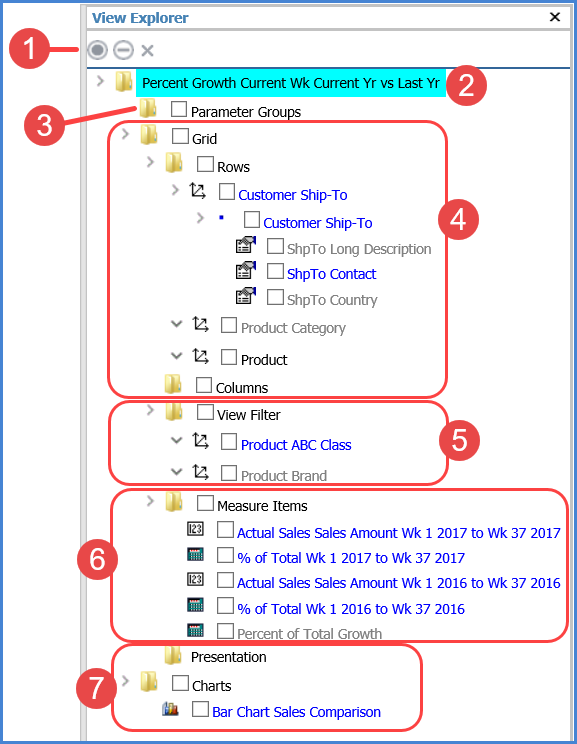

The elements in view explorer are organized into a tree structure that has expandable/collapsible folders and checkboxes for selecting items. Folders are described in the following table. Color-coding is used throughout to help you distinguish which items will be visible in the grid and which are hidden.
Items in blue text – Any items currently showing in the grid. Their Visible property is “Yes” in their Properties window.
Items in black text – Any items that are not actively shown in the grid, but that have a Visible property of “Yes.” This means they will display in the Navigation Panel as available to drill to and display in the grid once you reach them in the drill down path for the view.
Items in grey text – Any items that have a Visible property of “No.” For levels, this means they will not display in the grid as you drill through it. Attribute relationships, measure items, and charts displayed in grey text also will not display in the grid.
Checkboxes for folders and items – Select items using their checkboxes then use the icons in the view explorer toolbar as shortcuts for showing, hiding, or deleting items. You can select multiple items to apply those types of changes to at once..
Properties windows available for all items – When you double-click an item in view explorer, the Properties window of the active item opens at the bottom of view explorer. You also can right-click to invoke a pop-up menu of actions to take on items from view explorer. See also View Explorer Pop-up Menus.
|
View Explorer toolbar – Icons in the toolbar are shortcuts for hiding, displaying, or deleting items for the view. Select checkboxes for all the items you want to work with and then click the applicable icon:
|
|
View name folder – displays the name of the view. Double-click to access the Properties window for editing basic properties like the Name, Type, Planning, Export Type, and View Group properties. Administrators can use the Owner property to change the owner of a view. |
 |
Parameter Groups folder – Displays a view’s parameter groups and parameters within each group. Selecting the checkbox for this folder is a shortcut to selecting all groups within the folder, and selecting the checkbox for a group is a shortcut to selecting all parameters in the group. As you insert groups and parameters, they will display under this folder. Each group and parameter has a related Properties window. You can drag and drop groups and parameters within each group to rearrange them. |
|
Grid folder – The folders for Rows, Columns, View Filters, and Measure Items are organized under the Grid folder. From the Grid folder, you can access a Grid Properties window which determines if the grid is visible and if paging is enabled for the grid display. Selecting the checkbox for this folder is a shortcut to selecting all items in the view. Rows and Columns folders – All of the included levels and attribute relationships, grouped by hierarchy, display in their applicable Rows and Columns folders. Selecting the checkbox for a folder is a shortcut to selecting all items in that section. You can move hierarchies along with their levels and attribute relationships between the Rows, Columns, or View Filter by dragging and dropping them within view explorer or into the grid from view explorer. Properties windows exist for hierarchies, levels, and attribute relationships in these folders. Use them to hide or show items, set up filters or sorting, control the display of totals and All Others value defaults, etc.
|
|
View Filter folder – Levels included in the View Filter show in this folder. Setting up a view filter requires a level to be in the View Filter section and then applying a filter to that level. Drag or drop the desired level(s) into the View Filter section of the grid or into the View Filter folder of view explorer. Selecting the checkbox for this folder is a shortcut for selecting all items in the View Filter. |
 |
Measure Items folder – All measure items defined for this view display in the folder. Selecting the checkbox for this folder is a shortcut tor selecting the checkboxes for all measure items. You can edit, insert, remove and hide measure items. The Time Range controls the type of measure items that you can set up for the view – either measure items with time ranges (Yes) or measure items without time ranges (No). See the Measure Items properties window for detailed information. You can also use the Properties windows for individual measure items to change their caption, images, conditional formatting, pop-up labels, hyperlinks, filtering, sorting, totals, etc.
|
|
Presentation folder – The properties for this folder are used to set the default presentation format for the view (either Viewer or Excel) and to determine whether or not users will be prompted to choose the presentation format before the view opens for them. Chart folder
–
The Chart folder displays the names of any charts |